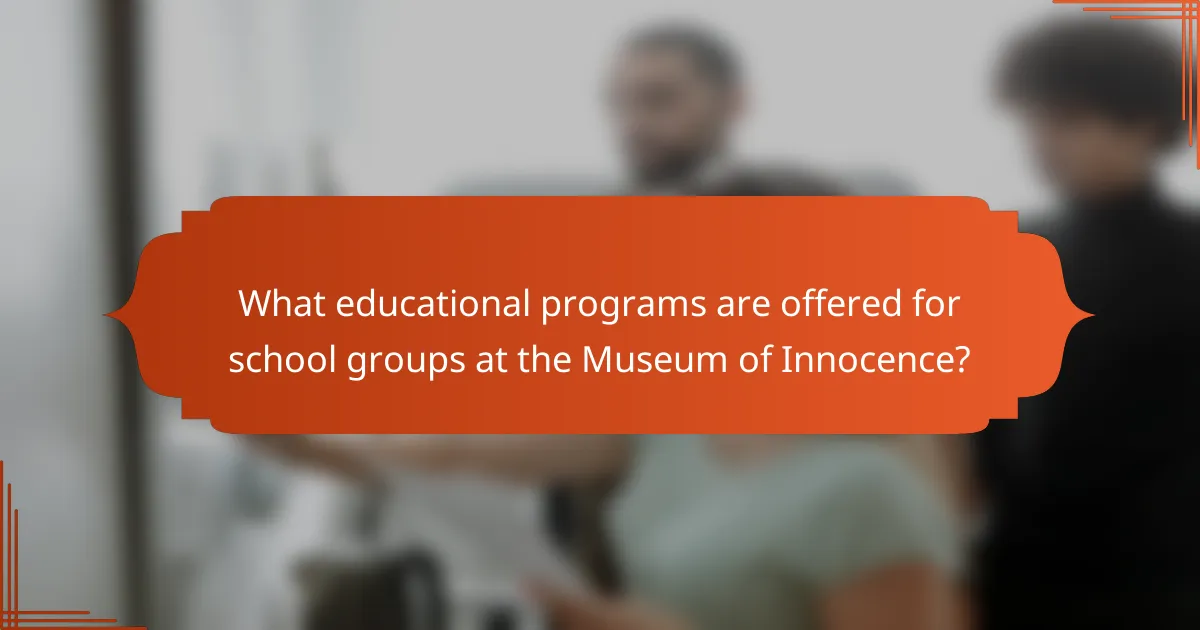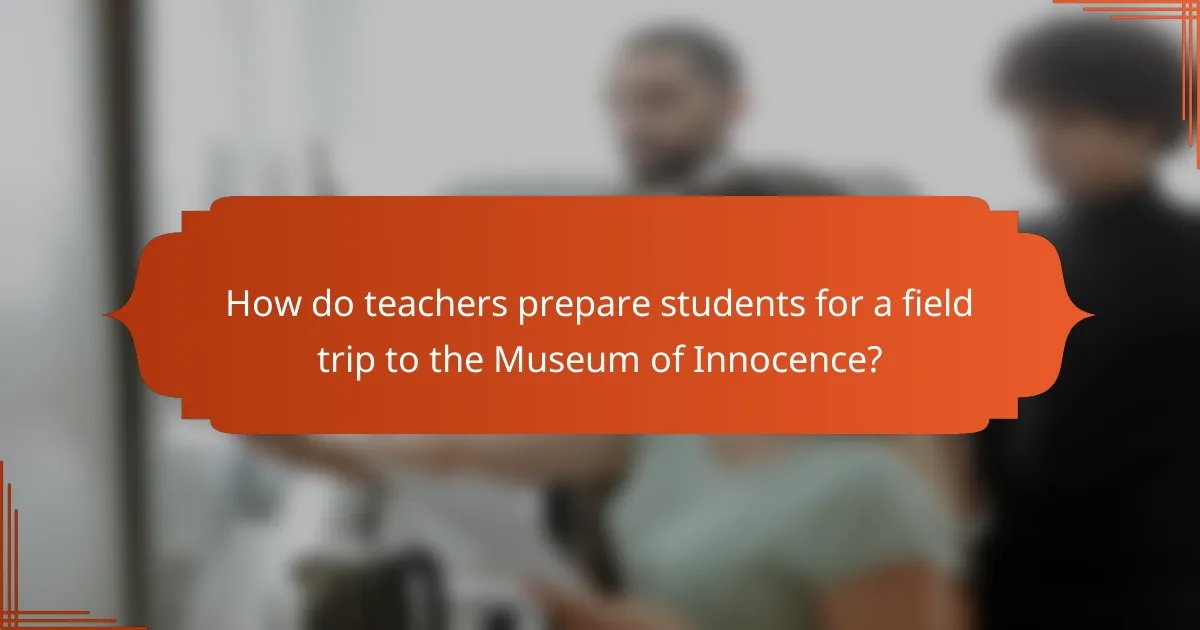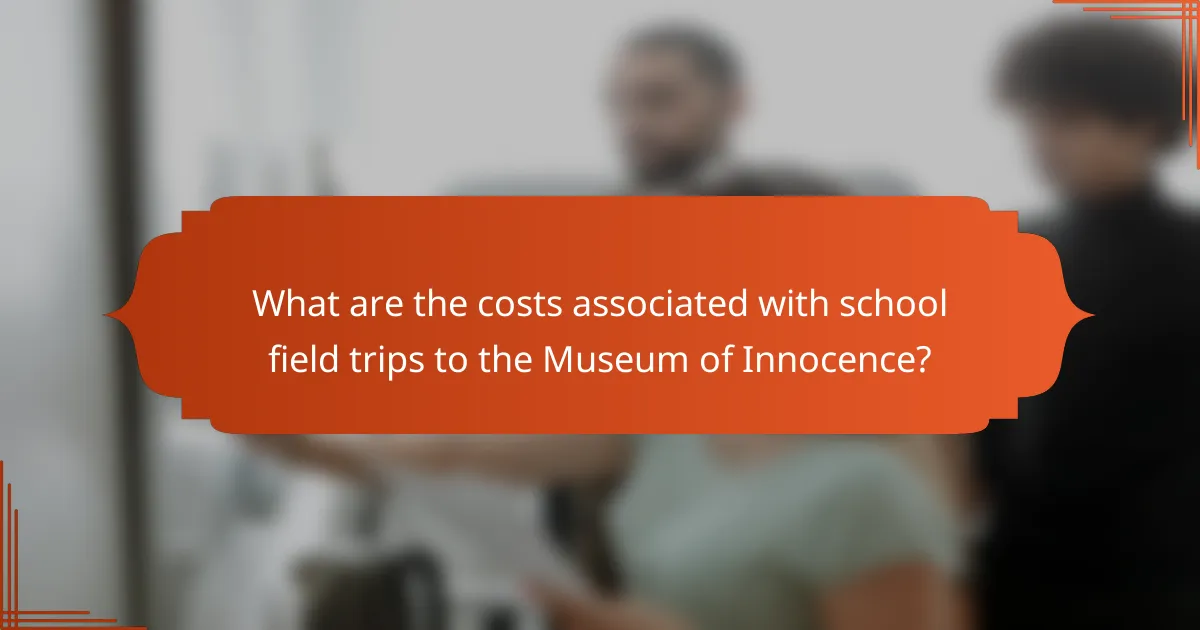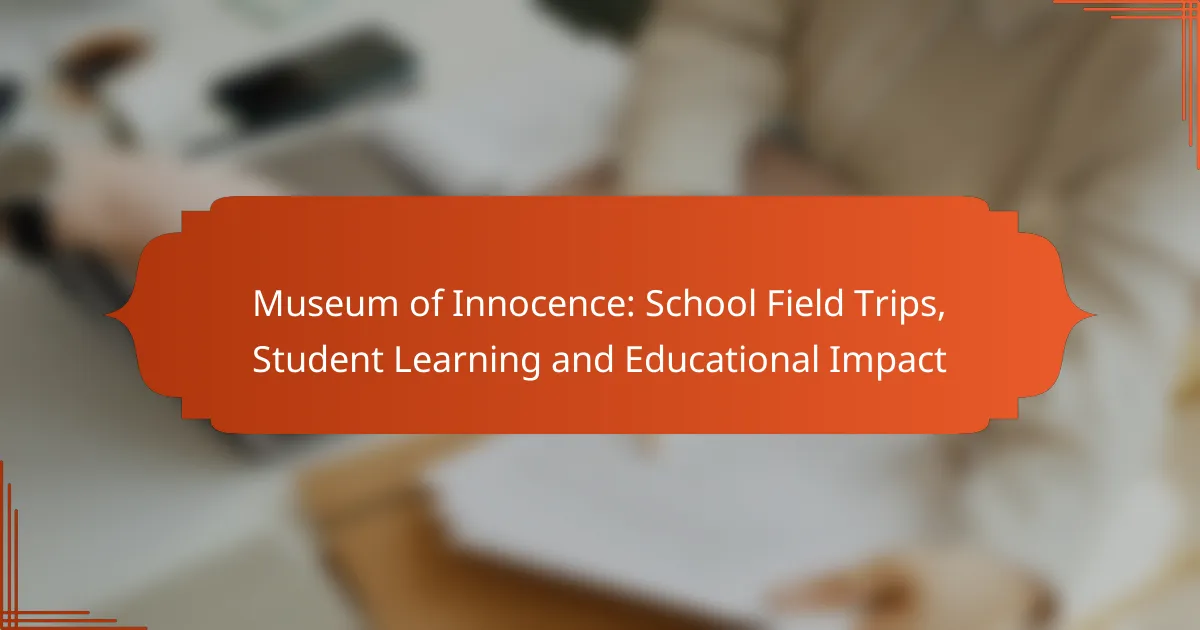School field trips to the Museum of Innocence offer students a unique opportunity to engage with cultural narratives and historical contexts, significantly enhancing their learning experience. Through immersive programs that connect literature, art, and cultural history, these visits foster critical thinking and emotional intelligence, bridging classroom knowledge with real-world insights.

How can school field trips to the Museum of Innocence enhance student learning?
School field trips to the Museum of Innocence can significantly enhance student learning by providing immersive experiences that connect classroom knowledge with real-world contexts. These trips foster engagement, critical thinking, and a deeper understanding of historical and cultural narratives.
Interactive exhibits promote engagement
The Museum of Innocence features interactive exhibits that captivate students’ attention and encourage active participation. By engaging with artifacts and multimedia presentations, students can explore themes of memory, love, and history in a hands-on manner.
For example, students may participate in guided tours that include storytelling elements, allowing them to relate personally to the exhibits. This interactive approach helps to maintain interest and enhances retention of information.
Real-world context for historical events
Field trips to the Museum of Innocence provide students with a tangible connection to historical events and cultural contexts. By examining the artifacts and narratives presented, students can better understand the socio-political landscape of Turkey during the 20th century.
This real-world context enriches their learning experience, as they can draw parallels between historical events and contemporary issues, fostering a more comprehensive understanding of history.
Encourages critical thinking and discussion
Visits to the museum stimulate critical thinking by encouraging students to analyze and discuss the themes presented in the exhibits. Engaging with complex narratives prompts students to ask questions and consider multiple perspectives.
Teachers can facilitate discussions post-visit, allowing students to reflect on their experiences and articulate their thoughts, which reinforces their analytical skills and promotes a culture of inquiry.
Supports curriculum standards in education
Field trips to the Museum of Innocence align with various educational curriculum standards by integrating art, history, and literature. These visits can be tailored to meet specific learning objectives across subjects, enhancing the overall educational experience.
Educators can design pre- and post-visit activities that reinforce the learning objectives, ensuring that the trip complements classroom instruction and meets educational benchmarks effectively.

What educational programs are offered for school groups at the Museum of Innocence?
The Museum of Innocence provides a variety of educational programs designed specifically for school groups, focusing on literature, art, and cultural history. These programs aim to enhance student learning through interactive experiences that connect them with the museum’s themes and exhibits.
Guided tours tailored for students
Guided tours at the Museum of Innocence are customized to engage students of different ages and educational backgrounds. These tours typically last around one to two hours and include discussions about the museum’s exhibits, emphasizing key themes such as memory and nostalgia.
During the tours, students can ask questions and participate in discussions, which helps deepen their understanding of the material. Teachers can also request specific focus areas to align the tour with their curriculum.
Workshops on literature and art
The museum offers workshops that combine literature and art, allowing students to explore creative expression through various mediums. These workshops often include activities such as writing exercises inspired by the museum’s themes or art projects that reflect their interpretations of the exhibits.
Workshops typically last between two to three hours and can accommodate small groups, ensuring personalized attention. Teachers are encouraged to integrate these workshops into their lesson plans to reinforce learning objectives.
Collaborative projects with local schools
The Museum of Innocence actively collaborates with local schools to create projects that foster community engagement and enhance educational experiences. These projects may involve joint exhibitions, student presentations, or thematic events that celebrate local culture and literature.
Such collaborations not only enrich the students’ learning experience but also promote a sense of ownership and pride in their work. Schools interested in partnering with the museum can reach out to discuss potential projects and how they can align with their educational goals.

What are the benefits of visiting the Museum of Innocence for students?
Visiting the Museum of Innocence offers students a unique opportunity to engage with cultural narratives and historical contexts, enhancing their educational experience. The museum fosters critical thinking and emotional intelligence through its immersive storytelling and artistic displays.
Exposure to cultural heritage
The Museum of Innocence serves as a gateway to understanding Turkish culture and history, showcasing artifacts and narratives that reflect societal values and traditions. Students gain firsthand insight into the complexities of cultural identity, which can deepen their appreciation for diversity.
Field trips to the museum can be integrated into various subjects, such as history, art, and literature, allowing educators to create interdisciplinary learning experiences. This exposure can spark interest in cultural studies and encourage students to explore their own heritage.
Development of empathy through storytelling
Storytelling is a powerful tool for developing empathy, and the Museum of Innocence excels in this area. By presenting personal stories and historical events, students can connect emotionally with the experiences of others, fostering a sense of compassion and understanding.
Engaging with the museum’s narratives encourages students to reflect on their own lives and the lives of those around them. This practice can enhance social awareness and promote discussions about social justice and human rights.
Inspiration for creative projects
The rich artistic and narrative elements found in the Museum of Innocence can inspire students’ creative projects, whether in writing, visual arts, or performance. The museum’s unique blend of art and storytelling provides a fertile ground for students to explore their creativity.
Teachers can encourage students to create their own stories or artworks based on their experiences at the museum, allowing them to express their interpretations and insights. This process not only reinforces learning but also nurtures individual expression and innovation.

How do teachers prepare students for a field trip to the Museum of Innocence?
Teachers prepare students for a field trip to the Museum of Innocence by developing lesson plans that align with the museum’s themes and objectives. This preparation includes engaging activities that enhance students’ understanding and appreciation of the museum’s exhibits.
Pre-trip lesson plans and activities
Creating effective pre-trip lesson plans is essential for maximizing the educational impact of the visit. Teachers can introduce topics related to the museum’s focus on memory, love, and social history through interactive activities, such as group discussions or creative projects. For example, students might create personal memory boxes to explore their own experiences.
Additionally, incorporating multimedia resources, such as videos or articles about the museum’s founder, Orhan Pamuk, can provide context and stimulate interest. This approach helps students connect their prior knowledge with what they will encounter during the field trip.
Discussion of themes and concepts
Before the trip, teachers should discuss key themes and concepts that the Museum of Innocence presents, such as nostalgia and the complexities of human relationships. Engaging students in conversations about these themes can deepen their understanding and encourage critical thinking. For instance, discussing how personal memories shape identity can lead to insightful reflections during the museum visit.
Teachers might also encourage students to consider how the museum’s exhibits reflect broader societal issues, fostering a more comprehensive understanding of the cultural context. This discussion can be facilitated through guided questions that prompt students to think critically about the exhibits they will see.
Safety and logistics planning
Safety and logistics are crucial components of field trip preparation. Teachers should ensure that all necessary permissions are obtained from parents or guardians, and that students are aware of safety protocols during the visit. A checklist can help streamline this process, including items such as emergency contact information and health considerations.
Additionally, planning the logistics of the trip, such as transportation and timing, is essential. Teachers should coordinate with the museum for group rates and guided tours, which can enhance the experience. It’s also advisable to conduct a pre-visit to familiarize themselves with the layout and facilities of the museum, ensuring a smooth experience for students.

What are the costs associated with school field trips to the Museum of Innocence?
Costs for school field trips to the Museum of Innocence typically include admission fees, transportation expenses, and potential discounts for educational groups. Understanding these costs can help schools budget effectively for enriching student experiences.
Admission fees for student groups
Admission fees for student groups at the Museum of Innocence are generally lower than standard adult tickets. Schools can expect to pay a reduced rate, often in the range of 5 to 10 USD per student, depending on the group size and any ongoing promotions.
It’s advisable for schools to contact the museum in advance to confirm current rates and any specific requirements for group bookings. This ensures that all students can participate without unexpected costs.
Transportation costs for schools
Transportation costs for school trips can vary widely based on distance and mode of transport. Schools located within the city may use public transport, which can cost a few dollars per student, while those traveling from further away might need to hire a bus, which could range from 100 to 300 USD for a round trip.
When planning, schools should consider the total number of students and chaperones to get accurate transportation quotes. Booking in advance can often lead to better rates and availability.
Available discounts for educational visits
The Museum of Innocence often provides discounts for educational visits, particularly for larger groups or during off-peak times. Schools should inquire about any special rates or packages that may be available to maximize their budget.
Additionally, some local educational programs or grants may cover part of the costs associated with field trips. Schools should explore these options to reduce expenses further and enhance the educational experience for students.

How does the Museum of Innocence measure educational impact on students?
The Museum of Innocence assesses educational impact through various methods, including feedback surveys, observational studies, and learning outcomes analysis. These approaches help determine how effectively the museum’s programs enhance students’ understanding of cultural and historical contexts.
Feedback Surveys
Feedback surveys are a primary tool for measuring educational impact. After field trips, students and teachers are encouraged to complete surveys that gauge their learning experiences, engagement levels, and overall satisfaction. This qualitative data provides insights into what aspects of the museum’s offerings resonate most with visitors.
Surveys often include questions about specific exhibits, activities, and the perceived relevance of the museum’s themes to students’ studies. Analyzing this feedback helps the museum refine its educational programs to better meet the needs of schools.
Observational Studies
Observational studies involve museum staff or educators monitoring student interactions during field trips. This method allows for real-time assessment of student engagement and comprehension as they explore exhibits. Observers can note how students respond to different displays and activities, providing valuable context for the survey data.
By combining observational insights with survey results, the museum can create a comprehensive picture of the educational impact on students, identifying both strengths and areas for improvement in their programming.
Learning Outcomes Analysis
Learning outcomes analysis evaluates the knowledge and skills students gain from their visits. This can include pre- and post-visit assessments that measure changes in understanding of specific topics related to the museum’s themes. Such assessments help quantify the educational benefits of the museum experience.
The museum collaborates with educators to align these assessments with curriculum standards, ensuring that the learning objectives are relevant and beneficial for students. This alignment enhances the educational value of field trips, making them a meaningful part of students’ academic journeys.
